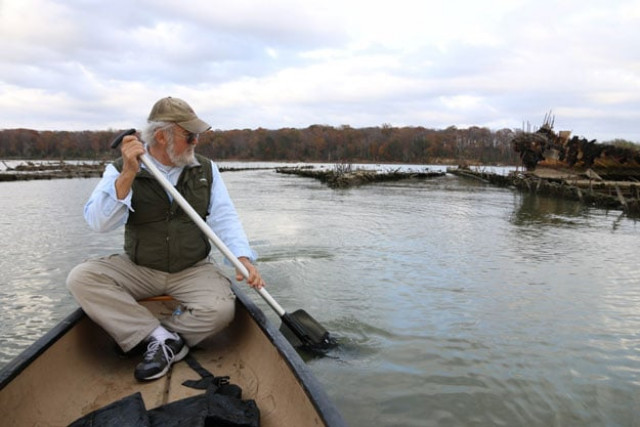Guarding the ghost fleet of Mallows Bay
Skeletons of more than 185 wooden steamships are remnants of an ill-fated fleet, commissioned in 1917

Marine archaeologist Don Shomette paddles a canoe among the remains of decaying sunken vessels left over from World War I in Mallows Bay near Nanjemoy, Maryland on November 17, 2015. PHOTO: AFP
It's a trip he's made thousands of times but as he rounds the corner upon scores of decaying ships left over from World War I, he is reminded why he keeps coming back to Mallows Bay.
"It's rather ironic that we have these ships which were engaged in a massive war of destruction now being reclaimed by nature," Shomette says, as he rows out onto the water.
Colombia finds treasure galleon, ending 300-year mystery
 The remains of a decaying sunken vessel left over from World War I is seen in Mallows Bay near Nanjemoy, Maryland on November 17, 2015. PHOTO: AFP
The remains of a decaying sunken vessel left over from World War I is seen in Mallows Bay near Nanjemoy, Maryland on November 17, 2015. PHOTO: AFPThe skeletons of more than 185 wooden steamships are remnants of an ill-fated fleet, commissioned in 1917 when the United States entered the Great War. By the time Germany surrendered, not a single one had crossed the Atlantic.
After a Congressional probe revealed the ships to be poorly designed and too expensive to maintain, production was halted and the ships were bought by a salvage company to use for parts and transported to the bay, an hour's drive south of the capital Washington.
After the Great Depression left the firm bankrupt in 1931, the vessels were left to decompose peacefully in the shallow waters of Mallows Bay.
Today, the rotted fleet is the largest group of historic watercraft visible in the Western Hemisphere.
Boat craftsmanship: A rising tide
A native of Maryland, the 72-year-old Shomette first visited Mallows Bay as a teenager.
Shomette's affinity for underwater archeology and history took him over the years from the coast of Yorkshire, England, to the depths of Lake Michigan, working as a consultant for groups such as National Geographic.
 The remains of a decaying sunken vessel left over from World War I is seen in Mallows Bay near Nanjemoy, Maryland on November 17, 2015. PHOTO: AFP
The remains of a decaying sunken vessel left over from World War I is seen in Mallows Bay near Nanjemoy, Maryland on November 17, 2015. PHOTO: AFPBut Shomette kept returning to the eerie collection of ships laying untouched nearly in his backyard. Eventually he obtained a grant and turned his passion into a work pursuit.
Over a 10-year period, Shomette collected and analyzed data from the ships, compiling a 500-page dossier documenting in great detail each member of the fleet.
"It is hard to say what my favorite projects are because all discovery is exciting," Shomette says. "But of course, Mallows Bay is incomparable."
"We have here a laboratory which we can test and study, and bring tourists to see history in the flesh."
Ship breaking: Call for proper waste management
Environmentalists have come to value the ships as a plethora of wildlife make their homes aboard their wooden remains, dense with shrubs and nutrient-rich soil.
The forested cove is home to many species of fish, birds, deer and beaver, among others. Shomette even recalls seeing a bald eagle land atop one of the ship's spiky hulls.
"Each ship has become a mini eco-system," said Joel Dunn, president of the Chesapeake Conservancy. "So whether it's an osprey to build a nest on, a striped bass to survive in or an oyster to cling onto, the ships provide structure for life to survive."
Dunn's non-profit organization is one of the groups pushing for Mallows Bay to be designated a national marine sanctuary, a process that is currently underway.
There are just 14 such sanctuaries in the United States. Last year, the National Oceanic and Atmospheric Administration (NOAA) announced its intent to expand the list for the first time since 2000.
Mallows Bay is one of two locations up for consideration.
The Mallows Bay sanctuary would encompass the entire ghost fleet from World War I plus dozens of other shipwrecks from earlier centuries that were subsequently brought to the area during the salvage years. NOAA describes the 14-square mile area as "one of the most ecologically valuable" sites in the state of Maryland.
Sammy Orlando, a NOAA coordinator for the Chesapeake Bay region, said the designation seeks to add an additional layer of protection to Mallows Bay, in addition to recognizing it for its historical and environmental value.
"It's really about the protection of these areas for future generations and the sustainability of the communities that are tied to natural and heritage resources of this area," Orlando said.
The proposal is undergoing public review, with local communities providing feedback to NOAA through a series of open hearings.
President Barack Obama offered his support when the process first began, but Mallows Bay still has quite a way to go before it earns official recognition.
Once NOAA makes a final decision, the Governor of Maryland and Congress will have a chance to review it. The earliest Mallows Bay would receive its designation is the fall of 2017.
Though the rustic waterscape has always been free and open to the public, the Maryland community hopes making Mallows Bay a sanctuary will put it on the map.
"We think that Mallows Bay Potomac River National Marine Sanctuary will become a major eco-tourism driver for Charles County and also the state of Maryland," Dunn said.
And for Shomette, the ships he has canoed around, scuba dived under, and written about for decades, would finally earn the recognition they deserve.



















COMMENTS
Comments are moderated and generally will be posted if they are on-topic and not abusive.
For more information, please see our Comments FAQ